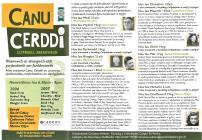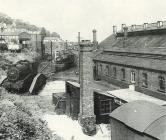Content can be downloaded for non-commercial purposes, such as for personal use or in educational resources.
For commercial purposes please contact the copyright holder directly.
Read more about the The Creative Archive Licence.
Description
Lede
Catching fish from the shore was but one of many ways to harvest the sea’s bounty in the history of Fishguard.
Story
It is thought that Fishguard was named from the Old Norse Fiskigarðr, a ‘fish catching enclosure’. What remains here today is very unlikely to date back that far but we know the style of low-walled hook-shaped trap is an ancient one. Remains of similar constructions can be found elsewhere around the coast of Wales and Scotland and indeed across the entire globe: the Pacific, South America, Southern Africa, Australia, Alaska and in many parts of Asia. Much like river weirs, the construction style must have been devised (or imitated) world-wide by communities of maritime folk who relied on a good fish catch to see them through the lean winter months. These fish traps were still in use around the British Isles in post-medieval times and possibly into the nineteenth century when large shoals of herrings were the mainstay of the economy of the twin towns of Fishguard and Goodwick. Catching fish from the shore was but one of many ways to harvest the sea’s bounty.
These ‘V’ shaped stone structures made use of the materials to hand but would have needed frequent maintenance to repair recurrent wave damage. Very likely, the heaped stone walls were extended with wooden hurdles or brushwood, traces of which have been found elsewhere as part of similar traps. The fish would have been captured on a falling tide (the highest spring tides would be best) when the outgoing shoals could be driven towards the barriers by people shouting and making a commotion in the water; the retreating tide would leave many fish stranded and they could then be scooped up and captured in baskets or nets or (we like to imagine) women’s skirts. It would surely be a communal activity in which able-bodied people of all ages would join and it no doubt generated a good deal of noisy excitement for the younger members of the crowd. “Tide’s turned, let’s go to the trap!”
The traps support a great deal of marine life: shellfish, prawns, crabs live in the crevices if you take the trouble to look. They are good places to see wading birds looking for food.
The north-west trap extends from a little way beyond the jetty or Fisherman’s Quay on the edge of Goodwick Harbour and can be seen (at low tide) as you walk along the road towards the ferry terminal. It appears on eighteenth-century maritime charts and on the first Ordnance Survey map in 1889. Part of the trap was destroyed by the construction of the harbour at the beginning of the twentieth century. The proposed development of a marina in early twenty-first century. would have meant the complete destruction of what remains but fortunately for the trap that did not go ahead.
The south-east trap can be viewed from the Marine Walk that runs along the cliffs at the back of the town. The trap lies just below the cliffs some distance beyond the old fishermen's cottages at the far eastern end of Goodwick beach. Access on foot is via the short flight of steps that can be found beside the brook as it flows down to the shore. Access to both traps should be undertaken with caution.
Although these old heaps of slimy stones along the muddy strand line have little obvious attraction to the regular holiday-maker we should acknowledge their significance in connecting the marine heritage of Twin Towns with that of far-flung communities the world over. People who lived by the sea came up with the same ideas and shared in the same activities with a common purpose. We must celebrate that and preserve these traps with as much care as any other remnant of the distant past.
Factoid
There are fish traps in Australia that are over 6,000 years old, older than the pyramids.





Do you have information to add to this item? Please leave a comment
Comments (0)
You must be logged in to leave a comment